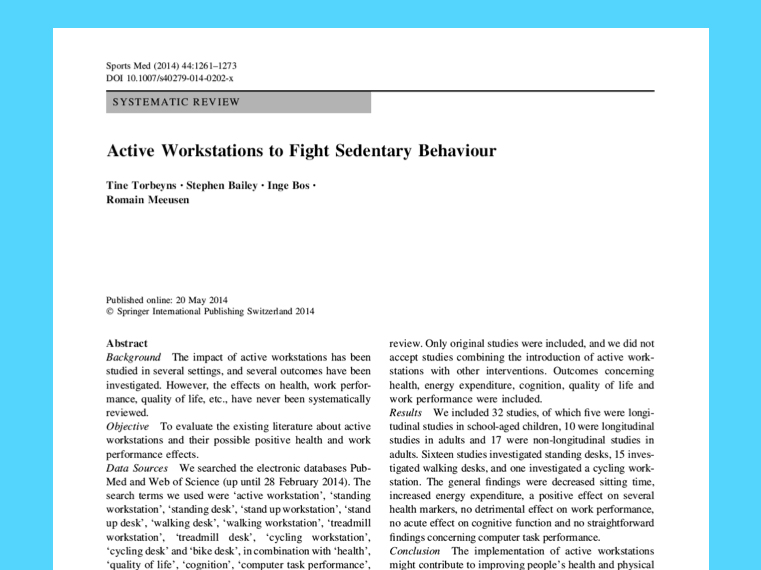
Do you get distracted or feel restless when you’re trying to study?
If so, you may want to try using an active workstation.
Active workstations (e.g., sit-stand desks, treadmill desks, and spin desks) allow you to incorporate physical movement into normally sedentary study/work tasks.
Research shows combining study with movement can boost your brainpower (e.g., improve your ability to focus and engage in complex cognitive tasks), decreases stress, and make it easier for you to learn.
In this article, I’ll share why it’s a good idea to incorporate some movement into your study sessions. I’ll also take you on a tour of my workspace to show you how I’ve set up my environment to support this habit.
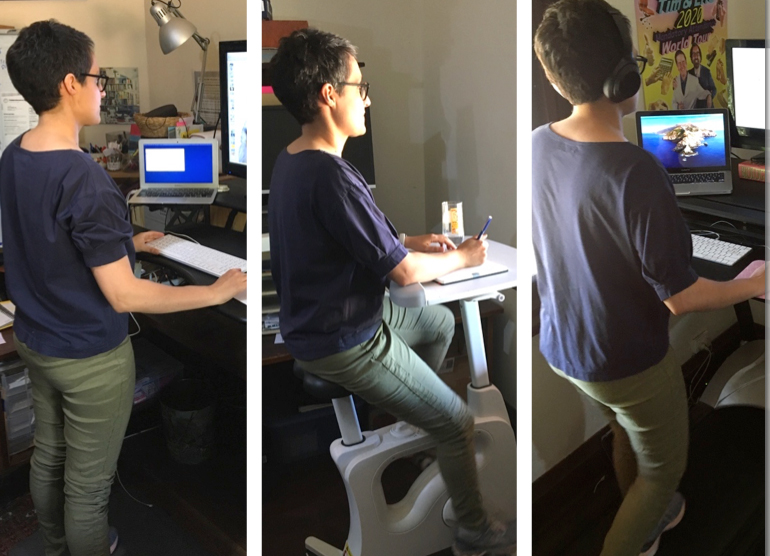
What’s the problem with sitting?
Some people say “Sitting is the new smoking”.
Whilst sitting isn’t as bad as smoking, research shows being sedentary can shorten your life expectancy and lead to chronic diseases.
In the famous double decker bus study, researchers compared the health of inactive bus drivers who sat for most of the day with active bus conductors who climbed on average 600 stairs each day on the double decker buses.
The researchers found the active bus conductors had lower rates of cardiovascular diseases than the inactive bus drivers.

As Dr Michael Greger states:
“Sitting more than three hours a day may be responsible for more than four hundred thousand deaths every year worldwide.”
But what are the immediate negative impacts of sitting for too long?
In the book Move the Body, Heal the Mind Dr Jennifer Heisz states when you sit for long periods of time, your body goes into hibernation mode.
Sitting for 4 or more hours results in a reduction of blood flow to your brain, which can leave you feeling sluggish and less alert.
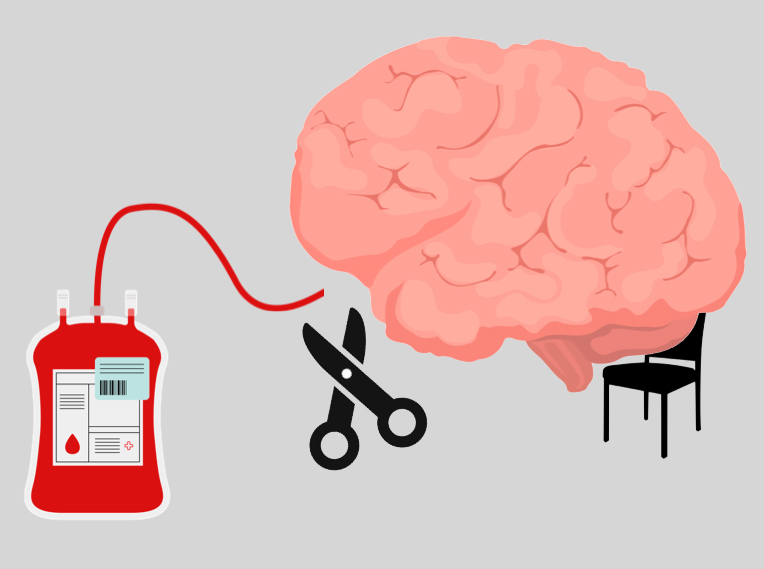
To combat these negative impacts, Dr Heisz suggests getting up from your desk every 30 minutes to take a 2 minute movement break.
But if you can move while you study/work, research shows you can experience even greater benefits.
Several studies have found people who use active workstations experience benefits such as:
• Increased energy levels
• Increased happiness levels
• Less stress
• Greater productivity
• Greater energy expenditure
This is why I’m a big fan of active workstations. They help me to feel good. And if I feel good, it’s so much easier for me to learn and get my work done.
The evolution of my workspace and habits
You don’t need to have a lot of money to incorporate an active workstation into your study routine. I’m living proof of this.
On a budget, I created a workspace that contains multiple active workstations and various pieces of gym equipment (e.g., dumbbells, yoga mat, and stretch bands).
My surrounding environment makes it easy for me to be active throughout the day. But not only that, being able to switch between workstations keeps things interesting for my brain.
When it comes to active workstations, you have choices. Below I list three different options for you to consider:
1. The Sit-Stand Desk
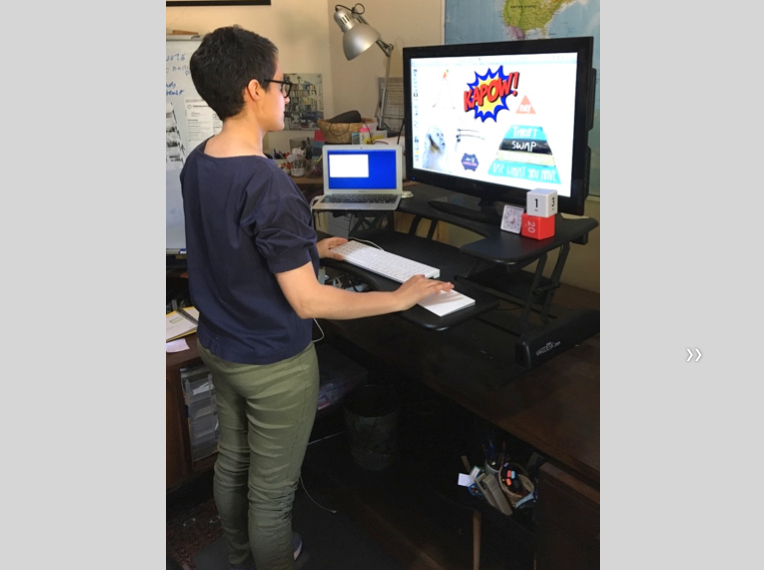
If you are new to the world of active workstations, a sit-stand desk is a great place to start. Using a sit-stand desk doesn’t require as much physical energy as other active workstations (e.g., treadmill desks and cycle desks). They are height adjustable which means when you get tired of standing, you can easily switch to sitting.
But is standing that much better than sitting?
The research suggests it is.
Dr Michael Greger points out:
“Even if you’re standing still, your postural muscles are tensed and stretched to fight gravity.”
When you’re standing, you’re also more likely to move around the room. For example, if I’m standing and I’m stuck on a problem, I will pace around my office or walk over to my whiteboard to sketch out ideas. In contrast, if I’m sitting in a chair it feels harder to get up and shift tasks.
All that being said, standing for long periods can get tiring. It can make your feet feel a bit sore, too. This is why a comfortable pair of shoes is essential. I also recommend placing an anti-fatigue mat or a soft pilates mat under your feet for maximum comfort.
2. The Treadmill Desk

Treadmill desks allow you to walk and work at the same time.
Students sometimes ask me “But isn’t this a form of multitasking? And you’ve just told us we shouldn’t multitask?”
It’s a good point.
Yes, technically using a treadmill desk is a form of multitasking. It involves performing two tasks at the same time (i.e. moving your legs and working on a computer). But here’s what makes it different from driving a car and texting or studying for a test with the TV playing in the background . . .
For most people, walking is an automatic process. You don’t have to use a lot of brainpower to walk.
This is why studies have shown walking at a slow pace while performing most tasks doesn’t negatively impact performance.
But like anything, using a treadmill desk does take some getting used to.
The key is to find the right walking speed and ease into it.
Don’t try to walk too fast, too soon, or for too long.
When I first started using my treadmill desk, I made the mistake of setting the speed to a brisk walking pace. After a few days, I was back sitting in my chair. My treadmill desk was neglected for many months.
But then someone suggested I try a slower walking pace. To my amazement, when I set the speed to 2km per hour, I found it much easier to walk and work.
Bottom line is this: Find a pace that feels right for you.
One downside with treadmill desks is they can be quite noisy (the motor and footfalls). If you’re trying to watch videos or attend an online meeting, I recommend using a pair of headphones.
3. The Cycle Desk
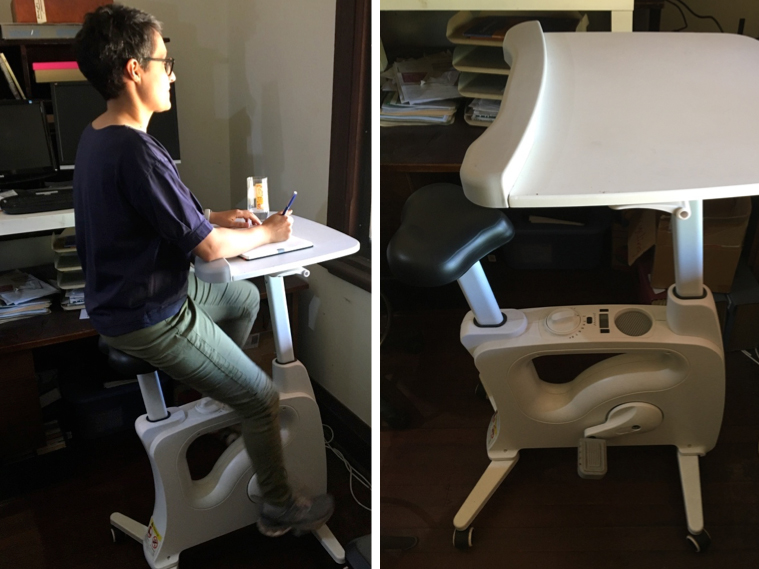
Do you prefer pedalling over walking?
If so, perhaps a cycle desk is for you.
Like a treadmill desk, you need to ease into it. It’s easier to work on a laptop and pedal at the same time if you start off with the resistance on the lowest setting. Once your brain gets used to the fact that your legs are moving while you’re working, you can bump up the resistance.
Most cycle desks come on wheels, which means you can easily move them around the house or outside for a change of scenery. They are also height adjustable which means when you get tired of pedalling, you can hop off and use it as a standing desk.
Matching the task to the workstation
It’s important to consider the tasks you need to do and whether the task is suitable for an active workstation. As much as I love my active workstations, I don’t proclaim to perform all tasks while I’m standing or moving.
Tasks that require intense concentration or physical dexterity (e.g., drawing) are best performed seated in a chair with your feet firmly planted on the ground. This is why I create mind maps at my kitchen table and my outdoor desk.
In contrast, active workstations work perfectly for browsing addictive websites and apps. If I feel the urge to watch YouTube videos or scroll through Twitter, I will force myself to go on my treadmill desk or cycle desk.
Using an active workstation stops me from mindlessly consuming content for hours on end. How? The movement acts as a stop mechanism. When my legs get tired, that’s my cue to stop and go do something else.

How to create a habit of using an active workstation
A lot of people buy active workstations with good intentions to move more but they struggle to cultivate the habit of using them.
This should come as no surprise. Sitting feels easy compared to standing, walking, and pedalling which all require physical effort.
The thing about your brain is it doesn’t like the thought of expending energy. Your brain will come up with all kinds of excuses to get you not to use your active workstation (e.g., “You’re too tired to stand” and “Using your treadmill desk is hard. Give yourself a break today. Go on, have a seat!”).

This is why it’s important to create a daily habit of using your active workstation (even if it’s just for a couple of minutes).
I recommend using the Tiny Habits Method. Engaging in some movement while you work is better than doing nothing.
If you go from sitting all day to standing and walking for hours on end, you’ll feel exhausted at the end of the day (and your chair will start to look very appealing!).
Here are some tiny habits I created to help me use my active workstations:
• When I want to check Twitter, I will turn on the treadmill and set it to speed 2.
• When I close my laptop at the end of the day, I will shift my desk to standing position.
• When I need to plan out a talk, I will grab my notebook and sit on my cycle desk.
Building an active workstation on a budget
You don’t need loads of cash to have an active workstation.
If you jump on Gumtree or Facebook Marketplace, you’ll notice a lot of people are trying to sell treadmills. The images these sellers share are usually of a treadmill in the garage that is covered in dust.
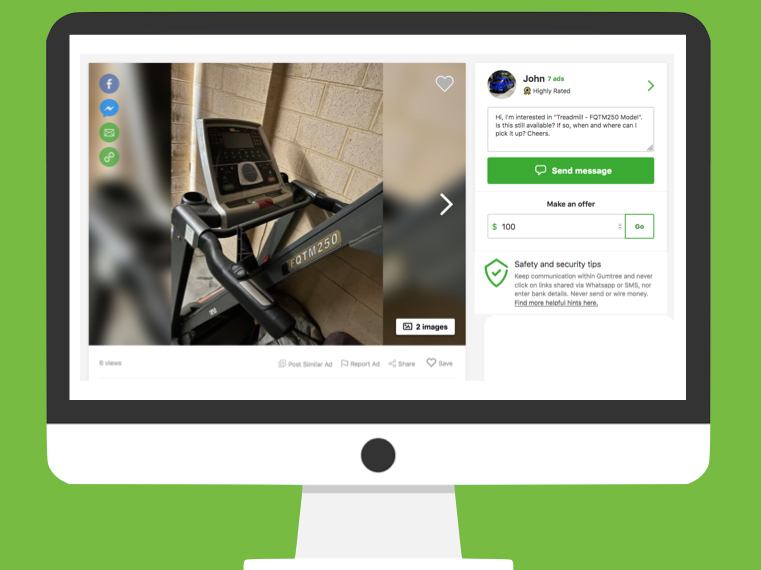
Why not pick a treadmill up for a bargain and convert it into a walking desk?
My treadmill desk cost me less than $50AUD to build. I picked up the treadmill for free. My dad helped me to add a desk to it out of recycled materials and some clamps.
To make it more ergonomic, I added a secondhand sit-stand desk on top ($40AUD off Gumtree). I then grabbed an old secondhand keyboard, mouse, and monitor to make it easy to plug in my laptop and shift workstations.
As for standing desks, you can build your own out of materials such as cardboard boxes and milk crates. The important thing is to get the height right. My husband built his sit-stand desk by placing an IKEA coffee table he found on the verge on top of his desk.
What if you don’t have the space for an active workstation?
If an active workstation isn’t possible for your living situation, don’t let that stop you from moving as you learn.
Head to your closest outdoor green space (e.g., your local park) with a set of flashcards. As you walk around the park, test yourself.
You can also build in regular movement breaks into your day. Here are some ideas for things you can do:
• Use stretch bands
• Do some stretches and yoga moves
• Put on a song to dance to
• Punch a boxing bag
• Use a skipping rope
Every little bit of movement you do counts. It all adds up.
To sum up
Incorporating movement into your study sessions is all about finding what works best for you. Whatever active workstation you choose to use, persevere. It takes time to adapt to working in a new way. But if you can stick at it, your brain and body will thank you for it.
